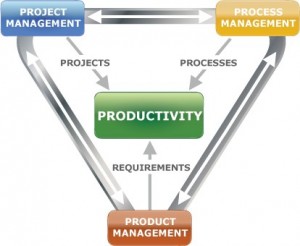What do Business Analysis and Entrepreneurship Have in Common?
If you are a BA, you may be wondering about your career options. To be honest, we all do that, but I tend to hear about career concerns from business analysts more than anyone. Should we aspire to be project managers when we grow up? That used to be the most common next step, and more BAs are saying “no way” to that. What about becoming business architects? That would be a logical move for “logical” people since architects tend to be abstract thinkers and focused on the “big picture.”
In March, 2014, Cathy Brunsting posted an insightful article In Modern Analyst called “Beyond the Business Analyst Role: What’s Next?” Besides the above options she mentioned Product Owner, Product Manager, and other managerial roles. To me, the product-oriented roles are the most conducive for a BA to use his or her skills to help their organization grow. Both roles take advantage of business knowledge and/or BA-type skills to define, refine, and steer development of new products.
Wait a second. Designing and developing new products is what entrepreneurs do, isn’t it? There is more to being an entrepreneur, which I’ll cover in another blog post. But, a critical part of starting a business or line of business is creating a new product or service or one that is better than the market currently has. That is often what business analysts do, and to some extent, project managers too.
Entrepreneur
. First, let me define entrepreneur; there are many definitions floating around. Translating from the French, entrepreneurs “undertakes a venture” which involves some risk. A longer and more precise definition from Investopedia (a favorite web site of mine) is the following:
“An individual who, rather than working as an employee, runs a small business and assumes all the risk and reward of a given business venture, idea, or good or service offered for sale. The entrepreneur is commonly seen as a business leader and innovator of new ideas and business processes.”
Entrepreneurs have been around for quite a while. The term was first used in the early 1700s. Classic examples of tech entrepreneurs are Steve Jobs and Mark Zuckerburg. Coco Chanel was a fashion and perfume innovator and entrepreneur in the 20th century. Levi Strauss created the Levi’s jeans company in the 1800s. James Watt was an 18th century entrepreneur. He didn’t invent the steam engine but he innovated several improvements on it.

Intrapreneur
. If you do entrepreneurial work inside an organization, the common term for you is “intrapreneur.” I don’t like the term because if one doesn’t assume risks then how can they be called a “preneur,” or someone who accepts risks? On the other hand, I very much like the concept of people in organizations starting up ventures to launch new products and services. Here is the Investopedia definition of intrapreneur:
“An inside entrepreneur, or an entrepreneur within a large firm, who uses entrepreneurial skills without incurring the risks associated with those activities. Intrapreneurs are usually employees within a company who are assigned a special idea or project, and are instructed to develop the project like an entrepreneur would.”
Now that we have some definitions in place, let’s move on to comparing business analysis and entrepreneurship.
Product vs. Project vs. Process. Years ago our company put together something we called the “productivity triangle.” Any organization is productive when they create or provide products or services that customers want and need. Creating them is done through projects, and project management is at the core naturally. Re-creating the new product on an ongoing basis is done through processes, which need to be improved or optimized periodically. Process management is central to that and projects may need launching to do the improvement.
Underlying both of these disciplines is product management. The easiest part of product management to grasp are the initial requirements and design. Another huge part of product management is developing business cases, which BAs often do at companies. Over time, additional requirements surface and new features are added and can be anywhere from small pieces to large releases. Product management both drives and supports projects and processes, completing the productivity triangle. See Figure 1.

Business Analysis and Entrepreneurship. So, what does this have to do with BAs
being entrepreneurs you may ask? If we view business analysis work as largely product management, BAs can port those skills to creating new products for a startup. Similarly, new product development within an organization can be done in an entrepreneurial way, and business analysis skills are critical. Speaking from experience, formal project management is helpful but not as crucial for a startup. (Scrum methods are more helpful, but that is a separate topic.)
Managing processes is the least important for a startup, since it won’t have processes to manage until it starts to “re-create” the products it has built. The other two legs of the triangle are essential for growing a company. Product management skills – which BAs have developed – are essential for starting a company or product.
I’m just getting started with the topic and will be delivering a keynote called “The Entrepreneurial BA” at the New Zealand BA Development Day conference in November. Look for additional posts soon!
References
https://www.investopedia.com/terms/e/entrepreneur.asp
https://www.investopedia.com/terms/i/intrapreneur.asp
Richard Larson, PMP, CBAP, PMI-PBA, was the founder of and is now a consultant for Watermark Learning. He is a successful entrepreneur with over 35 years of experience in product development, business analysis, project management, training, and consulting. As an internal entrepreneur, Rich led the development of several Watermark Learning online products as a business analyst and product owner.
Rich is a frequent speaker at Business Analysis and Project Management national conferences and IIBA® and PMI® chapters around the world. He has contributed as a lead author to the BA Body of Knowledge version 2.0 and 3.0 and was a lead author on PMI’s Business Analysis Practice Guide. He and his wife Elizabeth Larson have co-authored five books on business analysis.


 New Horizons
New Horizons
 Project Management Academy
Project Management Academy
 Six Sigma Online
Six Sigma Online
 Velopi
Velopi
 Watermark Learning
Watermark Learning
 Login
Login


 New Horizons
New Horizons
 Project Management Academy
Project Management Academy
 Velopi
Velopi
 Six Sigma Online
Six Sigma Online
 Watermark Learning
Watermark Learning